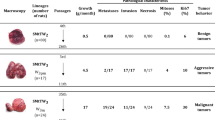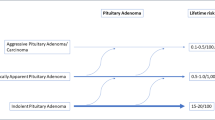Abstract
Although most pituitary adenomas behave in a purely benign fashion, microscopic invasion of the subjacent dura is very common, and clinically overt infiltration of the surrounding dura and bone is apparent at intraoperative inspection in about one third of cases. The factors governing invasive behavior remain unknown but are believed to be separate from those regulating cell proliferation. Histological features alone do not distinguish between benign, invasive, and malignant tumors of adenohypophyseal origin. Multiple attempts have been made to identify prognostic markers of aggressive behavior among these tumors. They include cytogenetic analysis of putative tumor suppressor genes or proto-oncogenes as well as immunohistochemical detection of cell-cycle specific antigens. At present, however, these analyses can neither distinguish the indolent pituitary adenoma from one that will pursue an invasive course, nor reliably predict the prognosis in individual patients.
Similar content being viewed by others
References
Scheithauer BW, Kovacs KT, Laws ER, Randall RV. Pathology of invasive pituitary tumors with special reference to functional classification. J Neurosurg 1986;65:733–744.
Rosenblum ML, McKerrow J, Patel A, et al. Identification of a mechanism for brain invasion by malignant meningiomas and preliminary development of an anti-invasive therapy. 1992 Congress of Neurological Surgeons Annual Meeting (abstract).
Kaltsas GA, Grossman AB. Malignant pituitary tumors. Pituitary 1998;1:69–81.
Cusimano MD, Ohori P, Martinez AJ, Jungreis C, Wright DC. Pituitary carcinoma. Skull Base Surg 1994;4:46–51.
Pernicone PJ, Scheithauer BW, Sebo TJ, et al. Pituitary carcinoma: A clinicopathologic study of 15 cases. Cancer 1997;79:804–812.
Stewart PM, Carey MP, Graham CT, Wright AD, London DR. Growth hormone secreting pituitary carcinoma: A case report and literature review. Clin Endocrinol 1992;37: 189–195.
Popovic EA, Vattuone JR, Siu KH, Busmanis I, Pullar J. Malignant prolactinomas. Neurosurgery 1991;29: 127–130.
Herman V, Fagin J, Gonsky R, Kovacs K, Melmed S. Clonal origin of pituitary adenomas. J Clin Endocrinol Metab 1990; 71:1427–1433.
Asa SL, Ezzat S. The cytogenesis and pathogenesis of pituitary adenomas. Endocr Rev 1998;19:798–827.
Bates AS, Farrell WE, Bicknell EJ, et al. Allelic deletion in pituitary adenomas reflects aggressive biological activity and has potential value as a prognostic marker. J Clin Endocrinol Metab 1997;82:818–824.
Thapar K, Kovacs K. Neoplasms of the sellar region. In: Bigner DD, McLendon RE, Bruner JM, eds. Russell and Rubinstein's Pathology of Tumors of the Nervous System, 6th ed. New York: Oxford University Press, 1996;561–677.
Takino H, Herman V, Weiss M, Melmed S. Purine-binding factor (nm23) gene expression in pituitary tumors: Marker of adenoma invasiveness. J Clin Endocrinol Metab 1995;80: 1733–1738.
Buchfelder M, Fahlbusch R, Adams EF, Kiesewetter F, Thierauf P. Proliferation parameters for pituitary adenomas. Acta Neurochir 1996 (Suppl);65:18–21.
Doniach I. Pituitary carcinoma. Clin Endocrinol 1992; 37:194–195.
Selman WE, Laws ER, ScheithauerBW, Carpenter SM. The occurrence of dural invasion in pituitary adenomas. JNeurosurg 1986;64:402–407.
Thapar K, Kovacs K, Scheithauer BW, et al. Proliferative activity and invasiveness among pituitary adenomas and carcinomas: An analysis using the MIB-1 antibody. Neurosurgery 1996;38:99–107.
Sautner D, Saeger W. Invasiveness of pituitary adenomas. Path Res Pract 1991;187:632–636.
Farrell WE, Simpson DJ, Bicknell JE, Talbot AJ, Bates AS, Clayton RN. Chromosome 9p deletions in invasive and noninvasive nonfunctional pituitary adenomas: The deleted region involves markers outside of the MTS1 andMTS2 genes. Cancer Res 1997;57:2703–2709.
Thapar BW, Kovacs K, Pernicone PJ, Laws EP. p53 expression in pituitary adenomas and carcinomas: Correlation with invasiveness and tumor growth fractions. Neurosurgery 1996;38:765–771.
LeRiche VK, Asa SL, Ezzat S. Epidermal growth factor and its receptor (EGF-R) in human pituitary adenomas: EFG-R correlates with tumor aggressiveness. J Clin Endocrinol Metab 1995;81:656–662.
Ezzat S, Smyth HS, Raymar L, Asa SL. Heterogeneous in vivo and in vitro expression of basic fibroblast growth factor by human pituitary adenomas. J Clin Endocrinol Metab 1995;80:878–884.
Shimon I, Hinton DR, Weiss MH, Melmed S. Prolactinomas express human heparin-binding secretory transforming gene (hst) protein product: Marker of tumor invasiveness. Clin Endocrinol 1998;48:23–29.
Clayton RN, Boggild M, Bates AS, Bicknell J, Simpson D, Farrell W. Tumor suppressor genes in the pathogenesis of human pituitary tumors. Hormone Res 1997;47:185–193.
Pei L, Melmed S, Scheithauer B, Kovacs K, Benedict WF, Prager D. Frequent loss of heterozygosity at the retinoblastoma susceptibility gene (RB) locus in aggressive pituitary tumors: Evidence for a chromosome 13 tumor suppressor gene other than RB. Cancer Res 1995;55:1613–1616.
Farrell WE, Talbot JA, Bicknell EJ, Simpson D, Clayton RN. Genomic sequence analysis of a key residue (Arg183) in human G;alphaq in invasive non-functional pituitary adenomas. Clin Endocrinol 1997;47:241–244.
Alvaro V, Levy L, Dubray C, et al. Invasive human pituitary tumors express a point-mutated alpha-protein kinase-C. J Clin Endocrinol Metab 1993;77:1125–1129.
Amar AP, DeArmond SJ, Spencer DR, Coopersmith PF, Ramos DM, Rosenblum ML. Development of an in vitro extracellular matrix assay for studies of brain tumor invasion. J Neuro-onc 1994;20:1–15.
Lei T, Xue D, Adams EF, Buchfelder M, Fahlbusch R. Relationship between invasiveness of pituitary somatotrophinomas and structural abnormalities of protein kinase C gene in human. J Tongji Med Univ 1997;17:68–71.
Thapar K, Kovacs K, Stefaneanu L, et al. Overexpression of the growth-hormone-releasing hormone gene in acromegaly-associated pituitary tumors: An event associated with neoplastic progression and aggressive behavior. Am J Path 1997;151:769–784.
Kawamoto H, Kawamoto K, Mizoue T, Uozumi T, Arita K, Kurisu K. Matrix metalloproteinase-9 secretion by human pituitary adenomas detected by cell immunoblot analysis. Acta Neurochir 1996;138:1442–1448.
Bravo R, Frank R, Blundell PA, Macdonald-Bravo H. Cyclin/ PCNA is the auxillary protein of DNA polymerase-d. Nature 1987;326:515–517..
Hsu DW, Hakim F, Biller BM, et al. Significance of proliferating cell nuclear antigen index in predicting adenoma recurrence. J Neurosurg 1993;78:753–761.
Ekramullah SM, Saitoh Y, Arita N, Ohnishi T, Hayakawa T. The correlation of Ki-67 staining indices with tumor doubling times in regrowing non-functioning pituitary adenomas. Acta Neurochir 1996;138:1449–1455.
Ikeda H, Yoshimoto T. The relationship between c-myc protein expression, the bromodeoxyuridine labeling index and the biological behavior of pituitary adenomas. Acta Neuropathol 1992;83:361–364.
Pegolo G, Buckwalter JG, Weiss MH, Hinton DR. Pituitary adenomas: Correlation of the cytologic appearance with biologic behavior. Acta Cytol 1995;39:887–892.
TaylorWA, Uttley D, Wilkins PR.Multiple dural metastases from a pituitary adenoma: Case report. J Neurosurg 1994;81:624–626.
Rieger A, Rainov NG, Ebel H, et al. Factors predicting pituitary adenoma invasiveness in acromegalic patients. Neurosurg Rev 1997;20:182–187.
Fitzgibbons PL, Appley AJ, Turner RR, et al. Flow cytometric analysis of pituitary tumors: Correlation of nuclear antigen p105 and DNA content with clinical behavior. Cancer 1988;62:1556–1560.
Anniko M, Wersall J. DNA studies for prediction of prognosis of pituitary adenmas? Adv Biosci 1988;69:45–52.
Landolt AM, Shibata T, Kleihues P. Growth rate of human pituitary adenomas. J Neurosurg 1987;67:803–806.
Knosp E, Kitz K, Perneczky A. Proliferation activity in pituitary adenomas:Measurement bymonoclonal antibody Ki-67. Neurosurgery 1989;25:927–930.
Daita G, Yonemasu Y. Dural invasion and proliferative potential of pituitary adenomas. Neurol Med-Chir 1996;36: 211–214.
Yonezawa K, Tamaki N, Kokunai T. Clinical features and growth fractions of pituitary adenomas. Surg Neurol 1997;48:494–500. 122 Amar et al.
Author information
Authors and Affiliations
Rights and permissions
About this article
Cite this article
Amar, A.P., Hinton, D.R., Krieger, M.D. et al. Invasive Pituitary Adenomas: Significance of Proliferation Parameters. Pituitary 2, 117–122 (1999). https://doi.org/10.1023/A:1009931413106
Issue Date:
DOI: https://doi.org/10.1023/A:1009931413106




